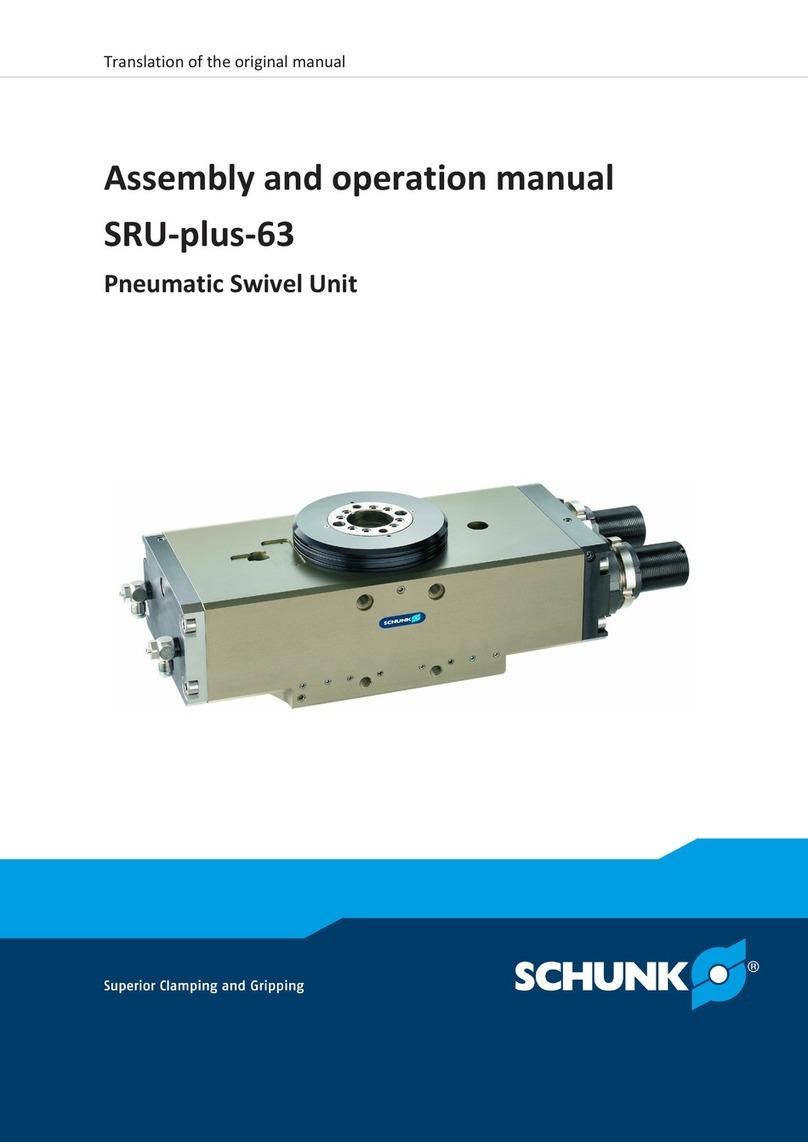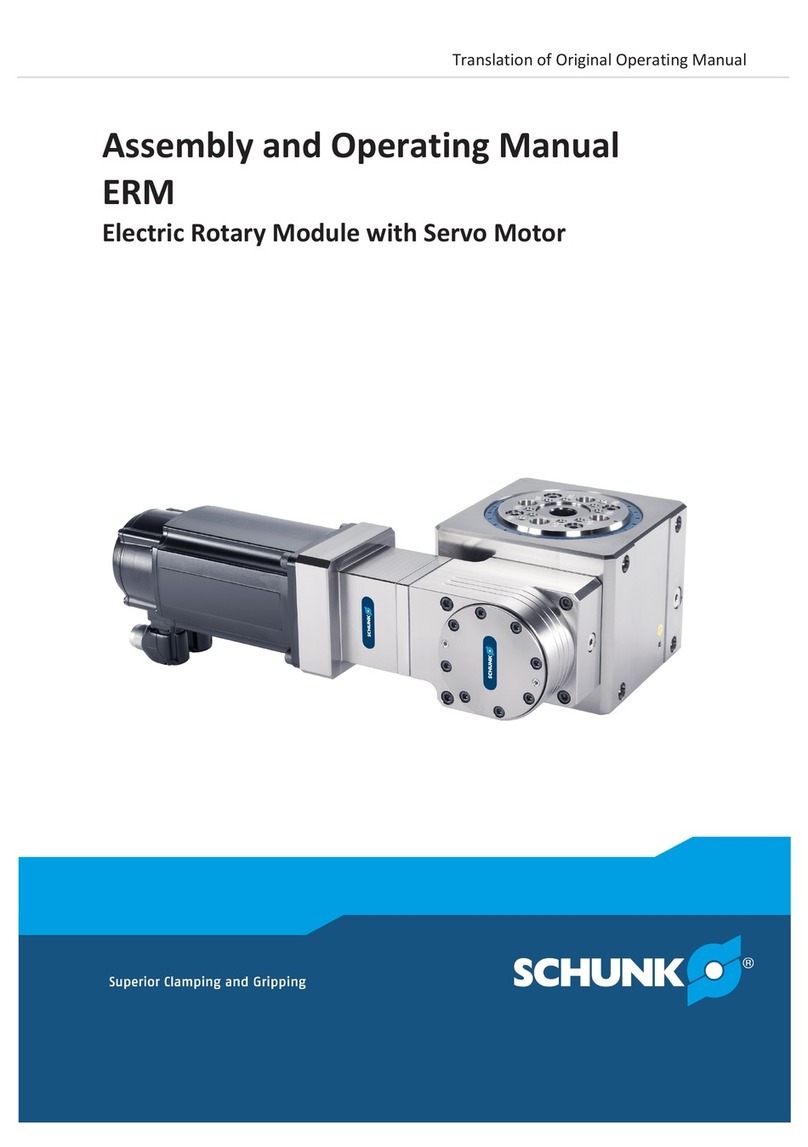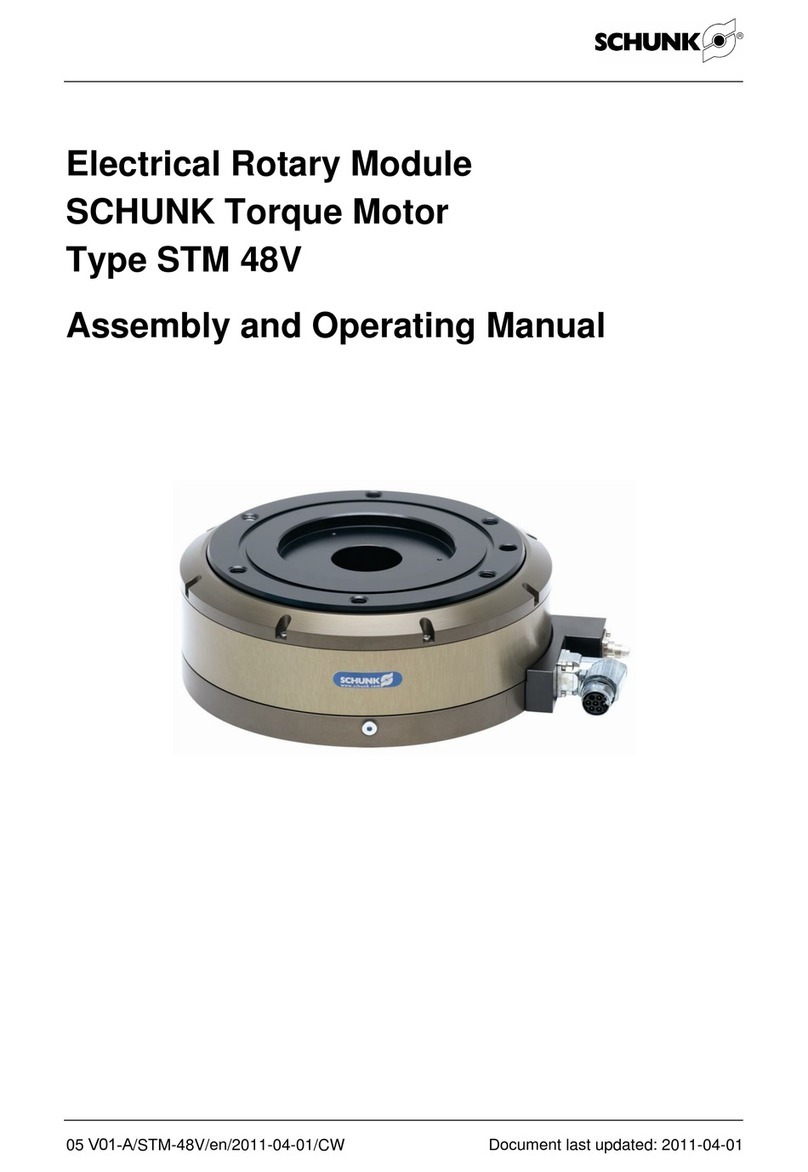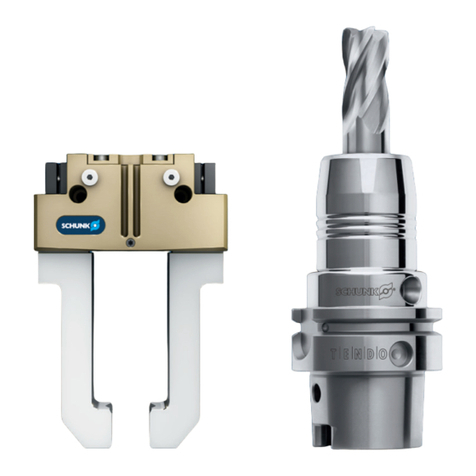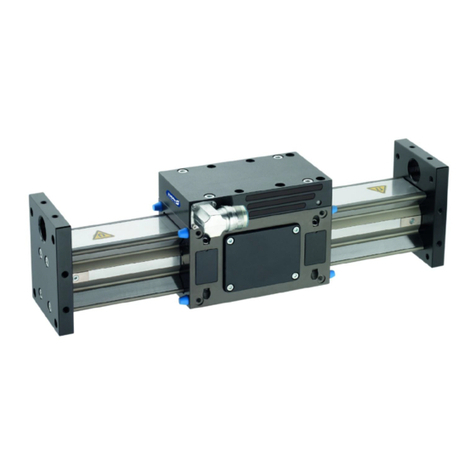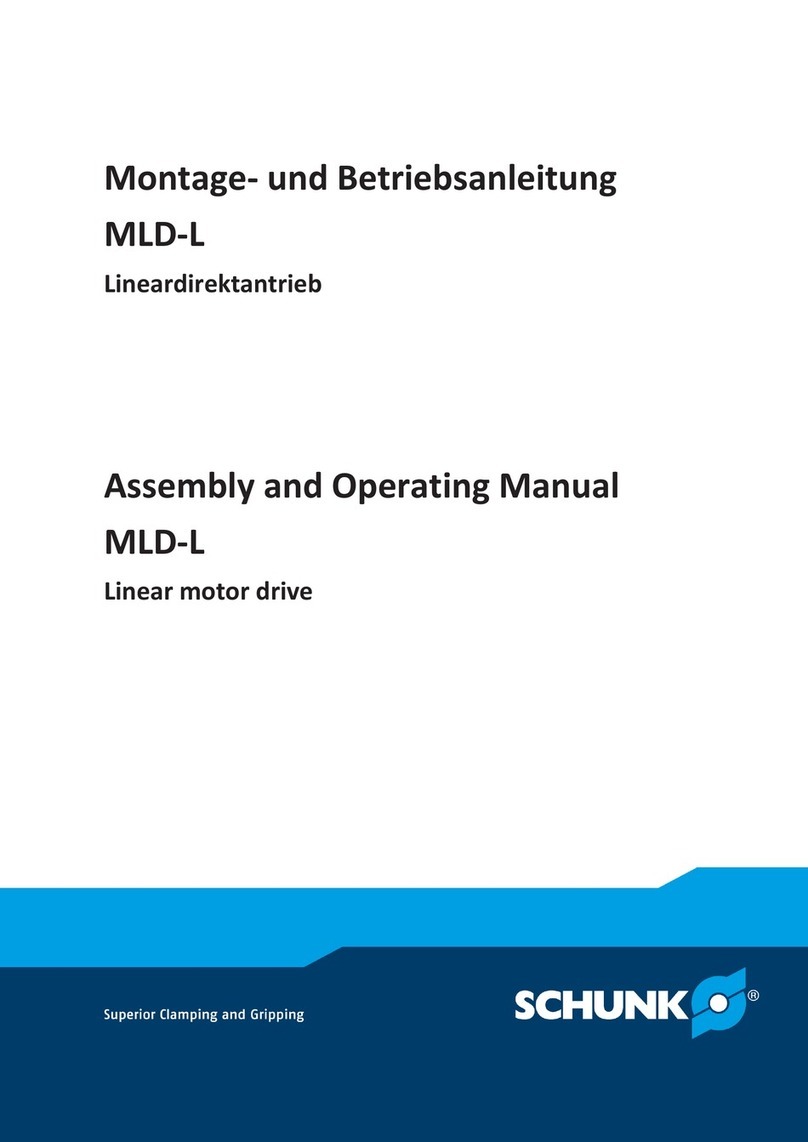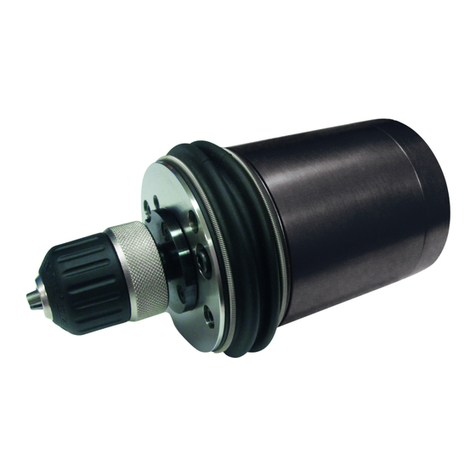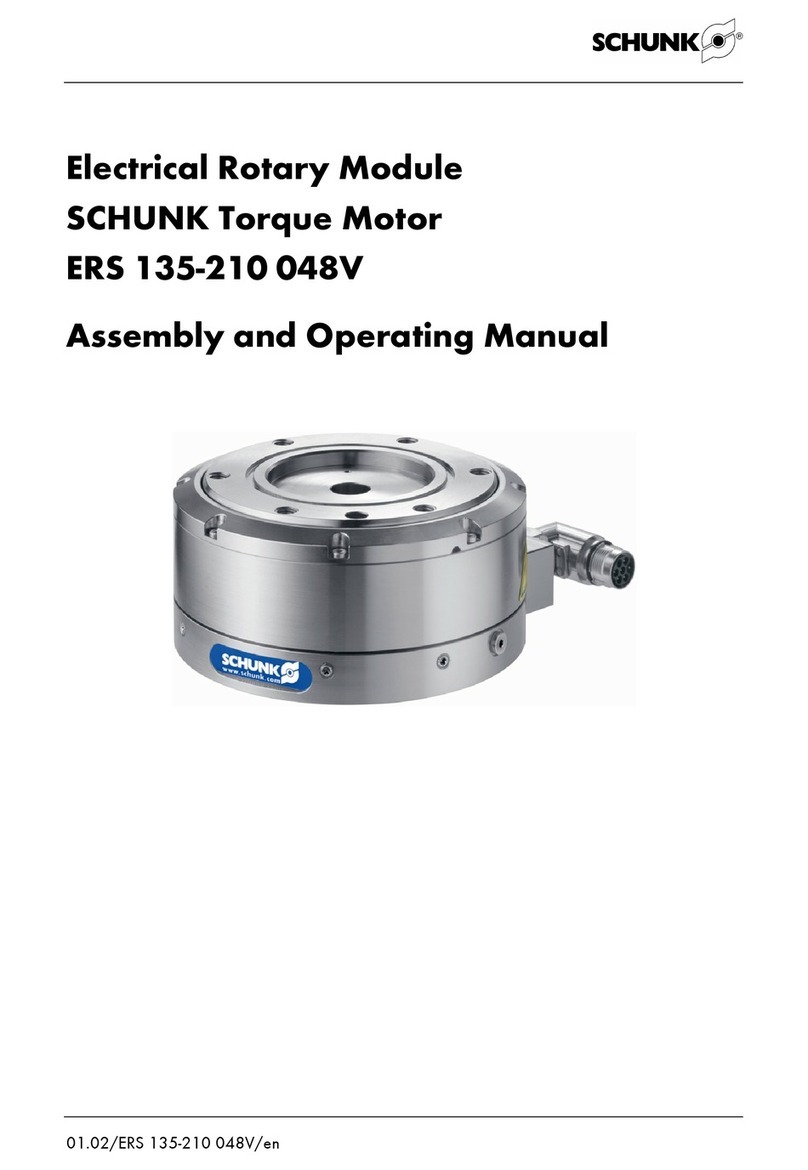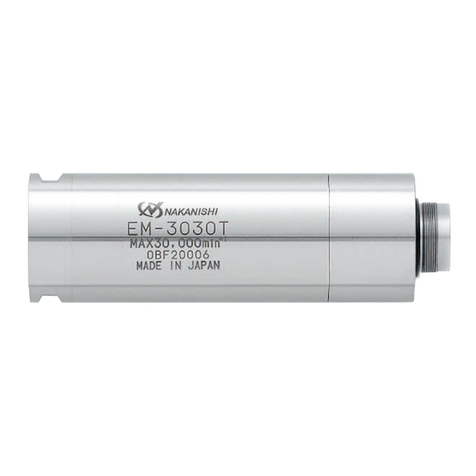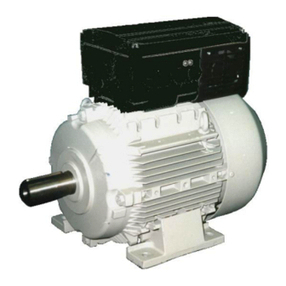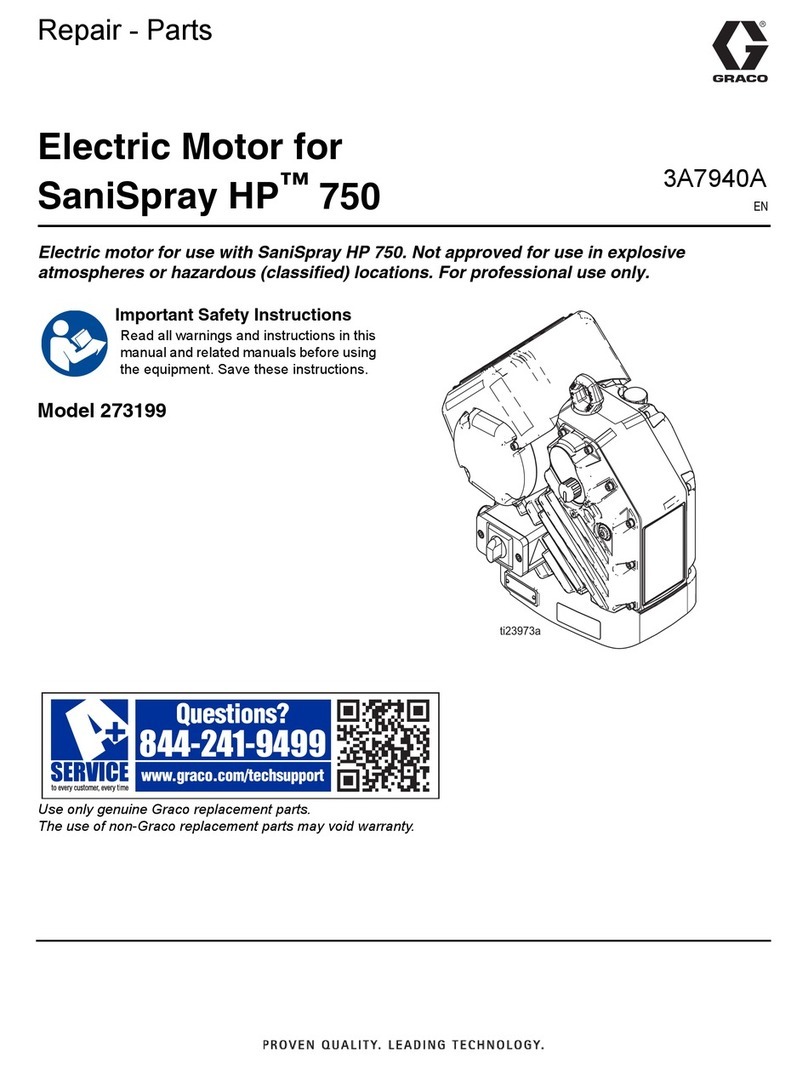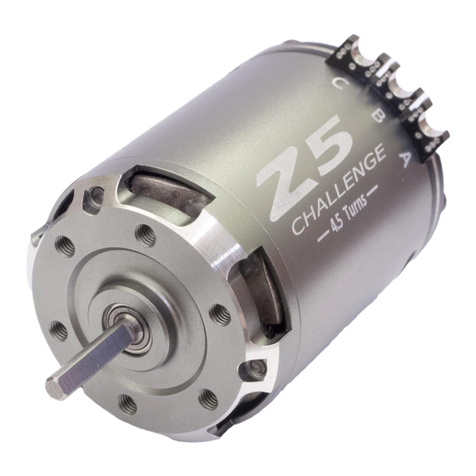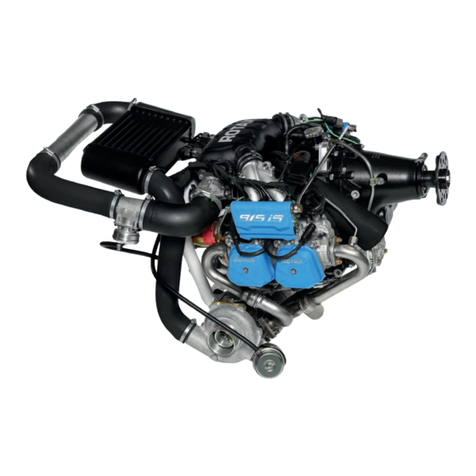
Copyright:
This manual is protected by copyright. The author is
SCHUNK GmbH & Co. KG. All rights reserved.
Technical changes:
We reserve the right to make alterations for the purpose of
technical improvement.
Document number:0289036
Edition:03.01|23/01/2023|en
SCHUNK GmbH & Co. KG
Spann- und Greiftechnik
Bahnhofstr. 106 – 134
D-74348 Lauffen/Neckar
Tel.+49-7133-103-0
Fax +49-7133-103-2399
schunk.com
4Operation
4.1Basic information
WARNING
Risk of injury due to ejected parts!
The max. speed of rotation of the machine/automated
system must be reduced when using long, projecting or
heavy tools and with extensions.
WARNING
Risk of injury and material damage due to the expansion
sleeve bursting!
If not used as intended, the expansion sleeve may burst. This
can cause metal shards and oil to be ejected from the
product under high pressure, resulting in serious injury.
•Never heat the product in heat shrink devices; only
perform a tool change using the integrated clamping
screw.
•Do not exceed the specified operating temperature.
CAUTION
Risk of injury from tools with sharp edges!
Sharp edges on tools can cause cuts.
•Wear protective gloves when assembling the tool.
NOTICE
Material damage due to burrs and dirt!
•The tool must be free of burrs and dirt at the shank.
•The machine interface must be free of burrs and dirt.
NOTICE
Material damage due to incorrect minimum clamping
depth!
Too small a clamping depth of the tool leads to a loss of
accuracy and torque on the product.
•Observe the minimum clamping depth of the tool.
NOTICE
Potential impairment of the clamping function and damage
to the product!
If the product is not used as intended, the clamping function
may be impaired or the product may get damaged.
•Only operate the clamping screw by hand.
•Do not adjust the projecting lengths of the tool when the
product is clamped.
4.2Assembly of tool and product
TENDO Turn DSE with one clamping screw
①Clamping screw ③ Length-setting range
②Minimum clamping depth ④ Length-setting screw
TENDO Turn DSE with two clamping screws
①Locking screw ④ Length-setting range
②Clamping screw 2 ⑤ Length-setting screw
③Minimum clamping depth ⑥ Clamping screw 1
TENDO Turn DSE with one clamping screw
1. Unclamp the product by loosening the clamping screw.
NOTE: The clamping screw is not secured against falling out.
2. If required, the projecting lengths of the tool can be
adjusted by screwing the integrated length-setting screw in
or out. Observe the adjustment travel of the length-setting
screw }Chap.3.
3. Insert the tool to the minimum clamping depth or stop.
4. Screw the clamping screw in by hand. Observe the specified
revolution for pre-loading }Chap.3.
✓The tool is pre-loaded.
5. Position the product with pre-loaded tool correctly in the
machine interface and fit up to the stop.
6. Screw the clamping screw in by hand until it reaches the
stop. Observe the maximum specified tightening
torque }Chap.3.
7. Check that the product is in the correct position and
securely clamped in the machine.
IMPORTANT!Safe clamping of the product in the machine
must be ensured!
NOTE: Always clamp the inner diameter first! Only after
clamping the inner diameter is the outer diameter fully
cylindrical.
TENDO Turn DSE with two clamping screws
1. Unclamp the product by loosening clamping screws 1 and 2.
NOTE: Clamping screw 1 is not secured against falling out.
2. If required, the projecting lengths of the tool can be
adjusted by screwing the integrated length-setting screw in
or out. Observe the adjustment travel of the length-setting
screw }Chap.3.
3. Insert the tool to the minimum clamping depth or stop.
4. Screw clamping screw 1 in by hand until it reaches the stop.
Observe the maximum specified tightening
torque }Chap.3
✓The tool is pre-loaded.
5. Position the product with pre-loaded tool correctly in the
machine interface and fit up to the stop.
6. Screw clamping screw 2 in by hand until it reaches the stop.
Observe the maximum specified tightening
torque }Chap.3.
7. Check that the product is in the correct position and
securely clamped in the machine.
IMPORTANT!Safe clamping of the product in the machine
must be ensured!
NOTE: Always clamp the inner diameter first! Only after
clamping the inner diameter is the outer diameter fully
cylindrical.
4.3Tool change
TENDO Turn DSE with one clamping screw
1. Carefully loosen the clamping screw until the product can
be removed from the machine interface. IMPORTANT!If
the clamping screw is turned out too far, the tool is no
longer pre-loaded!
2. Remove the product from the machine interface.
3. Unclamp the product by fully loosening the clamping screw.
NOTE: The clamping screw is not secured against falling
out!
4. Remove tool.
5. Mount new tool }Chap.4.2.
TENDO Turn DSE with two clamping screws
1. Unscrew clamping screw 2 until it reaches the stop.
2. Remove the product from the machine interface.
3. Unclamp the product by fully loosening clamping
screw 1.
NOTE: Clamping screw 1 is not secured against falling out!
4. Remove tool.
5. Mount new tool }Chap.4.2.
5Maintenance and storage
5.1Cleaning the clamping bore
Clean the clamping bore during every tool change with a
cleaning agent containing solvents and a cleaning brush.
5.2Checking the clamping force
Check the clamping force before initial use, after approx. 100
tool changes and at least every 3 months.
1. Unclamp the product by loosening the clamping screw.
NOTE: The clamping screw is not secured against falling
out!
2. Insert the test shaft to the minimum clamping depth.
3. Screw the clamping screw in by hand until it reaches the
stop. Observe the maximum specified tightening
torque }Chap.3.
4. The clamping force is no longer sufficient if the test shaft
can be pulled out of the product with little effort using two
fingers.
In this case, send the product to SCHUNK for inspection.
5.3Lubricating the clamping screw
CAUTION
Allergic reactions if lubricating grease comes into contact
with the skin.
•Wear protective gloves to lubricate the clamping screw.
It is necessary to adapt the cleaning and lubrication of the
clamping screw to the ambient conditions. Especially in the
case of high clamping frequencies, high operating
temperatures, and abrasive dirt or dust. For optimum
lubrication of the clamping screw, we recommend copper
paste MOLYKOTE CU 7439. (100 g tube, ID 9247204).
1. Unscrew the clamping screw from the product.
IMPORTANT!The actuating piston underneath is not
secured against falling out and must not be removed!
2. Clean the clamping screw and actuating thread and check
for damage to the thread flanks. Replace if necessary.
3. Lubricate the clamping screw and actuating thread.
4. Screw the clamping screw into the product.
5. Check the clamping force }Chap.5.2.
5.4Storage
– Lightly oil the entire surface of the product.
– Only store the product in an unclamped state and protected
against corrosion.
– Store the product in a suitable transport container.
– Protect the product from excessive temperature fluctuations.
NOTE: Before recommissioning, clean the product and check
for damage, functionality and tightness!
If you have any questions regarding maintenance and servicing,
our technical after-sales service is available during our business
hours:
Service telephone: +49-7133-103-2956
service.toolholder@de.schunk.com
6Disposal
– Follow local regulations on dispatching product components
for recycling or proper disposal.
– Alternatively, you can return the product to SCHUNK for
correct disposal.
